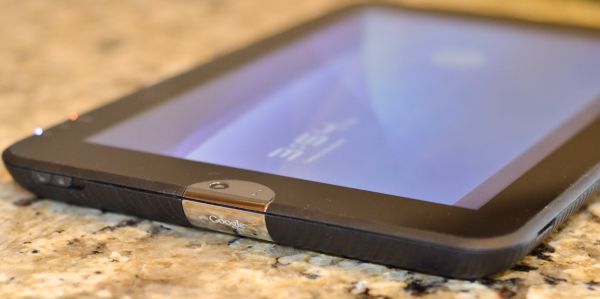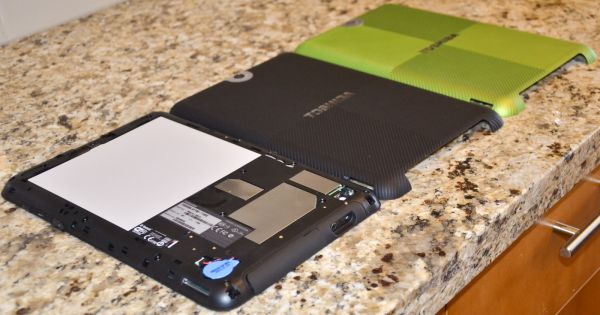Toshiba Thrive: Honeycomb Hits $300
by Vivek Gowri on December 12, 2011 3:00 AM ESTDesign-wise, the Thrive is a mixed bag. From the front, it looks pretty generic, save for a chrome webcam surround. The screen is obviously the dominant feature here, though the larger bezel leaves it with a larger footprint than the rest of the 10” tablets. Beyond that, the front of the tablet has the front facing camera, mic, light sensor, and notification LEDs for power, battery, and WiFi—pretty simple.
The back of the Thrive is more interesting; the battery cover takes up the entire rear portion, with a rubberized texture and chrome Toshiba badging. The curve of the sides and the texture make the Thrive feel pretty comfortable to hold, which is nice. The Thrive is a bit too wide to be ideal for one-handed use in landscape orientation, but for portrait and two-handed use, the design works well. The chrome webcam surround from the front wraps around to the back to house the rear facing camera as well.
It’s the single worst thing about the Thrive’s design—a distinctly cheap industrial design element on an otherwise clean, if somewhat generic, device. I’m not sure who at Toshiba decided this was a good idea, but evidently they liked it enough to push it to the 7” Thrive as well. The chrome plastic doesn’t help—if it was matte black plastic, or even a less-bright metal, I think I’d be a fan, just for adding an element of visual interest. But in chrome? It just looks kitschy.
The lid otherwise is pretty cool. It’s one of the few recent tablets with a removable battery, which is always nice. Toshiba offers a number of replacement lids in different colors—I got a bright green one from them; other options include silver, dark blue, lavender, and a magenta-type color that Toshiba calls Raspberry Fusion. It adds a nice touch of color to the otherwise completely black device, and the cost is surprisingly reasonable (I’ve seen them go on sale for $5-7 pretty regularly).
The best part of the design is the port selection. There are real, life-sized ports on board here—a USB port for connecting input devices and mass storage, a full-sized HDMI port (no smaller connectors or anything here, hooray!), a full-sized SD card slot, a mini-USB port to connect the tablet to a computer, and the standard headphone/mic combo jack.
All of these ports are hidden by a cover that basically is just a thin plastic contour that is attached to the tablet by a strip of flexible plastic that's begging to be fatigued into failure or simply torn off with an errant gesture. It holds itself to the tablet using small plastic clips, and has the unique distinction of being at once poorly built, annoying to use, and basically devoid of any functionality. If this were my personal unit, I would tear the cover off, it doesn't serve much purpose other than keeping dust out of the ports. That usually doesn't present itself as a problem on other mobile devices with exposed connectors, so I just don’t see the point.
Toshiba definitely made some missteps with the design and build here, but they show that they are learning. Their next tablet, the Excite, measures at exactly 7.7mm thick and 558g (basically one-upping the Galaxy Tab 10.1 and Transformer Prime), has none of the odd design elements that the Thrive does, and generally seems to bring Toshiba into the high-end of the Android tablet market. We’ll see about pricing and availability, but $499 and February wouldn’t be a bad bet. Either way, the Thrive isn’t nearly competitive with the Galaxy Tabs and iPads of the world from a device hardware standpoint. We expected that going in given the price delta, but it’s still worth noting that you do get what you pay for from a design standpoint.




















33 Comments
View All Comments
wapz - Monday, December 12, 2011 - link
I would imagine the 7" Kindle Fire is a more interesting buy for the money if you want to get a sample of tablet for a budget. And it will run ICS very soon thanks to a lot of dev-support.This will have hardly any dev-support due to probably low sales, and because it runs Tegra, and nVidia still hasn't released HALs and userspace drivers for Tegra open source which means there is a fair amount if reverse engineering to be done to properly make a custom rom based on AOSP.
Try harder, Toshiba, this isn't good enough.
Hrel - Monday, December 12, 2011 - link
I like the cheap replaceable color cases. I like the full size ports... A LOT!!!! The hardware is way above the bare minimum level that is acceptable. Still, build quality matters. I'll be recomending amazon kindle fire or Transformer still. As far as the thickness goes, I REALLY don't care, do whatever you have to do to use full size ports. I don't care so much about full size USB but full size SD card and HDMI are pretty much required.*rant:
Personally I still don't see the appeal of these things. I bought the Asus and used my new toy for like 2 weeks. Then a couple months later noticed I hadn't touched the thing so I sold it off. I have a laptop, which goes anywhere in my house easily and I can take it on the road easily, and I have a desktop. I honestly do not understand the appeal of these things. You're giving up functionality and not really saving any money. I just do not understand. I have the Clevo P151 laptop, not light or thin. I have no issues moving it around. I have a laptop bag and power adapters so battery life is a non issue. I type a lot, and it has a BEAUTIFUL screen. Again, I see ZERO appeal in owning a tablet. Especially when you often get suckered into paying 100+/month to use the damn thing on wireless networks. You can't run ANY windows apps or games, again, I don't get it. I am baffled that anyone buys these things at all. A 4 inch "smartphone" that you can use as a GPS and Mp3 player, I get that... you know, for 50 bucks/month or less. But anything bigger isn't any more portable than a laptop. Baffling. Virgin mobile has a 25/month plan for a smartphone, you can tether anything to it. That seems like a fair deal. But as soon as you start slaping 2GB 4GB 40GB/month bandwidth limits, no matter how big 250GB/month it's instantly worth nothing. Either, you NEED that bandwidth, or you don't. If you do you get charged INSANE amounts of money to use it. And if you don't you're already paying INSANE amounts of money for that bandwidth. If you use 1GB/month of wireless data you should be paying next to nothing. This infuriates me, that people pay it. Because it's never going to change until people say enough. Cell carriers could easily charge 25/month for "access", meaning EVERYTHING in unlimited quantities and still make BILLIONS of dollars/year. Yes ATT you would have to build out your wireless network. Guess what? THAT'S THE FRAKKING BUSINESS YOUR IN!!!!
LancerVI - Monday, December 12, 2011 - link
I agree. My wife loves the Asus Transformer I bought for her.She goes everywhere with it.As for me, I can't stand using the damn thing!!!sprockkets - Monday, December 12, 2011 - link
It's simple, for those people who hate installing software, issues with windows, etc.Belard - Monday, December 12, 2011 - link
Each to their own. A few years ago I bought my first notebook... The concept was... Why bother. My needs didn't warrant the purchase. But going to court and needing a reliable way to show evidence or burn a disc made the $500 purchase worth it. So it was used only a few hours out of it's first year. I use it more when I need mobility but my desktop is my main baby. We bought an iPad for business promotion at a major international convention where any notebook or Netbook would have failed.Just like the notebook, some people or application works best for that formfactor.
Tablets are used like books, far more comfortable than a notebook in bed or sofa. Not for heavy work. When sharing information with people on the con floor, a tablet blows the door off any notebook. Show me a notebook that weighs about a pound, easy to use, with instant on Internet access, 8-9 hours of battery usage? Carrying extra batteries and power brick, etc means weight and space. A real keyboard would have been in the way and awkward to hold when showing clients system operations and materials. Show me a $400 notebook that can be turned on in 1 second and have wifi access in 1-3 seconds... There is nothing else. A 4" screen phone is a personal communications device... Not a sales tool.
( typed on my bed from my iPad). Even thou I have a quad core desktop available...
rpmurray - Wednesday, December 14, 2011 - link
*rantPersonally I still don't see the appeal of laptops. Desktops do the same and more and are generally cheaper to boot. Laptops can't be upgraded (other than memory and hard drive and you pay through the nose for both), have batteries that you need to keep charged, have cramped keyboards and the screens are so tiny compared to the ones you can get for a desktop. Again I see ZERO appeal to a laptop. Even budget desktops have faster CPUs. You can get so much more done with a desktop than a laptop in the same amount of time. And that doesn't even cover all the crap you have to lug around with you when you have a laptop (charger, spare battery, cables and dongles for the ports and any external hardware you use with it, carrying case to haul it all around in). And the INSANE amount of money you have to pay for a laptop in the first place compared to a desktop, even before you get all the add-ons.
piroroadkill - Monday, December 12, 2011 - link
Take notice.Take the 1280x800 IPS panels from these tablets and put them in little netbooks.
Brazos E-450 based netbooks. Done, I'd buy it.
I'm not buying a 16:9 netbook, simple as that.
Impulses - Monday, December 12, 2011 - link
You really gotta wonder why no one's done this already, the panels can't be that expensive if they're going into $350 tablets. Even if it raises the price of such a netbook past $550 there'd probably still be a market for it.One of the several reasons I bought my TF is the display itself...
Oh and btw, it took ASUS for-freaking-ever but they finally released their 40-pin to USB/SD adapters the full size ports on the Thrive aren't much of upside anymore. Sure it's one more little thing to carry but if you wanna use gamepads, hard drives, or thumbdrives without the kb dock then it's well worth it.
A5 - Monday, December 12, 2011 - link
The simple answer is that the tablets (especially the iPad) have killed the netbook market.The other reason is that an ARM SoC + Free OS (Android) is cheaper than an Atom CPU + Chipset + Windows license, enabling manufacturers to spend more on the screen.
melgross - Monday, December 12, 2011 - link
Microsoft has a standard for what is called a netbook for the purpose of selling Win7 Starter (and the earlier versions) to manufacturers making netbooks.The main points are:
1. 10" screen
2. 1024 x 768 max resolution
3. atom CPU.
If a manufacturer moves out of those basic specs, it's no longer a netbook, and they can't buy Starter, they must buy one of the regular versions.